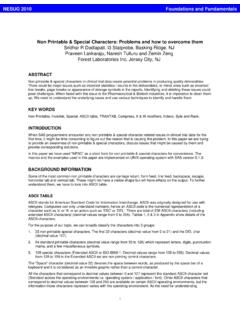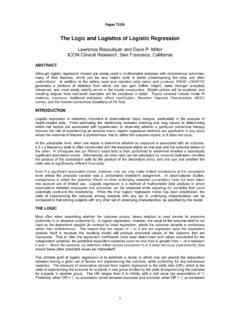Transcription of Adverse Event Analysis - One step forward!
1 PhUSE US Connect 2018 1 Paper AB02 Adverse Event Analysis - One step forward! Anuja Rasal, Syneos Health, Pune, India ABSTRACT From Headache (mild AE) to a Cardiac Arrest (severe AE); every Adverse Event in a clinical trial is often summarized by their occurrence, percentage of occurrence, severity, seriousness, outcome, relation to treatment and so on. Adverse Events of special interests which are sometimes critical to the study report Analysis or interim Analysis of a trial are categorically analyzed for AE Onset Date, AE Duration along with their descriptive statistics. Statistical significance testing is done using Fischer s Exact, Chi-square test. Extrapolating incidences of Adverse events is done by calculating exposure-adjusted incidence rate, 100-patient years. Risk-Rate Analysis by calculating their odds ratios between treatment groups for AE s of special interest shows the power of statistical Analysis in analyzing the safety avenue of a trial.
2 We will look into more detail of such kind of Adverse Event Analysis in the article to follow. INTRODUCTION An Adverse Event (AE) is any untoward medical occurrence in a patient or clinical investigation subject administered a pharmaceutical product and which does not necessarily have a causal relationship with this treatment. Similarly we have various classifications of Adverse events depending on various factors. Adverse events can conventionally be analyzed by displaying frequency and percentages. They can also be analyzed by displaying incidences of their occurrences by treatment and reporting period and they can be statistically analyzed using tests for exact and goodness of fit like Fischer s and Chi-square test. We will be looking into different methods available for Analysis of Adverse events. From this Analysis , clinicians and statisticians interpret and report data to the regulatory agencies by means of clinical study report, safety narratives and manuscripts per patient to take appropriate action.
3 Let s look into some AE definitions and categories required for such Analysis . Adverse EVENTS CATEGORIES AND DEFINITIONS Adverse Event (AE) occurring in a subject can be referred as - An Adverse Event (also referred to as an Adverse experience) that can be any unfavorable and unintended sign ( , an abnormal laboratory finding), symptom, or disease temporarily associated with the use of a drug, without any judgment about causality or relationship to the drug. - An Adverse Event that can arise from any use of the drug ( , off-label use, use in combination with another drug) and from any route of administration, formulation, or dose, including an overdose. Adverse Drug Reaction (ADR) An undesirable effect, reasonably likely to be caused by a study drug and it may occur as part of the pharmacological action of the study drug or may be unpredictable in its occurrence. Expected Adverse events An expected AE is any Adverse reaction whose nature and intensity have been previously observed and documented for the study product ( in the investigator brochure, product information).
4 Unexpected Adverse Event An AE or suspected Adverse reaction is considered "unexpected" if it is not listed in the investigator brochure or is not listed at the specificity or severity that has been observed; or, if an investigator brochure is not required or available, is not consistent with the risk information described in the general investigational plan or elsewhere in the current application, as amended. Serious Adverse Event (SAE) An AE meeting one of the following conditions - Death during the period of protocol defined surveillance. - Life threatening (defined as a subject at immediate risk of death at the time of the Event ) - Hospital admission during the period of protocol defined surveillance. - Any Event that results in congenital anomaly or birth defect. PhUSE US Connect 2018 2 - Any Event that results in a persistent or significant disability/incapacity.
5 - Any other important medical Event that may not result in death, be life threatening, or require hospitalization, may be considered a serious Adverse Event when, based upon appropriate medical judgment, the Event may jeopardize the subject and may require medical or surgical intervention to prevent one of the outcomes listed above. Non-serious AE - These are all AEs that do not meet the above criteria for serious . Intensity of the AE - All AEs in the database are assessed by the investigator using the protocol defined grading system. If the protocol has no defined grading system, then guidelines such as the following will be used to quantify intensity - Mild: Transient or mild discomfort (<48 hours) to the subject; no medical intervention/therapy required. - Moderate: Mild to moderate limitation in activity of the subject - some assistance may be needed; no or minimal medical intervention/therapy required.
6 - Severe: Marked limitation in activity of the subject, some assistance usually required; medical intervention/therapy required hospitalization possible. Adverse events of special interest (AESIs) An AE or a group of AEs of scientific and medical concern specific to the sponsor s product or program, which may require further investigation in order to characterize and understand them. Example AESIs include peripheral events, infections, and hypersensitivities etc. Some AESIs can be addressed using a Medical Dictionary for Regulatory Activities (MedDRA) standardized MedDRA query (SMQ) and should be addressed with a MedDRA SMQ if one exists for the medical concept of interest. Exposure Adjusted Incidence rate (EAIR) EAIR of AEs is defined as the number of subjects exposed to the drug and experiencing a certain Event divided by the total exposure time of all subjects who are at risk for the Event .
7 Specifically, for subjects with no Event , the exposure time is the time from the first drug intake to the last follow-up assessment; for subjects with at least one Event , the exposure time is the time from the first drug exposure to first Event . Treatment Emergent Adverse Events (TEAE) A treatment-emergent Adverse Event is defined as any Event not present prior to the initiation of the drug treatment or any Event already present that worsens in either intensity or frequency following exposure to the drug treatment. SAFETY Analysis Safety Analysis in a clinical trial encompasses analyzing different measurements taken during the reporting period of the trial. Adverse events recorded by the principal investigators at the investigation sites are the primary ones as any reaction that the subject has during the period is or can be due to the administration of the study drug. Other measurements include the vital signs, ECG, laboratory measurements that appear to be abnormal when compared to the ones that are acceptable as per the Investigator Brochure (IB) or product information.
8 For example; Increase or decrease in systolic or diastolic blood pressure, or an abnormal ECG reading after a meal and the drug dose administration can signal into an Adverse reaction happening in the subject s body which should be analyzed. Numerous different safety parameters are analyzed while monitoring the safety avenue of a clinical trial which is mentioned in the protocol and the type of Analysis is mentioned in the statistical Analysis plan after sponsor or client approval are done. These measurements of safety for Adverse events or vital signs or an abnormal laboratory reading are usually analyzed and displayed in a summary table with their occurrences and percentages of occurrences among the total number of subjects at risk or the safety population. Shift tables are created for laboratory readings to find out the change in values of subjects showing low, normal or high readings at baseline and have a shift in these values after drug administration.
9 It represents cross-frequencies of baseline values with post-dose values. The laboratory assessments include various measurements like hemoglobin , Creatinine, Fasting Plasma Glucose, Bilirubin, BUN (Blood Urea Nitrogen) and many more. PhUSE US Connect 2018 3 Adverse Event Analysis Existing statistical methodology to evaluate the efficacy of a study drug in clinical trials is well-developed. However, the research on the safety Analysis , including AE data, is very limited. In a clinical trial requiring statistical Analysis , sample size determination generally requires patient enrollment to meet the efficacy criteria, while safety Analysis is done only for exploratory purposes. Therefore, the majority of clinical trials simply request AEs to be tabulated and/or listed without any inferential statistical Analysis . However, recent research demands rigorous Analysis on AE datasets in clinical trials.
10 When preparing the statistical reports, clinical investigators and medical writers often ask biostatisticians and SAS programmers to provide statistical Analysis on safety profiles, more often for a submission to regulatory authority such as the Data Monitoring Committee (DMC) or Adjudication Committees. These committees aid in implementing appropriate stopping rule or undertaking interim Analysis which were not originally decided as per the protocol. Often the interim analyses are pre-decided by the clinicians and statisticians and other stakeholders of the study or compound in cases of rare diseases or therapeutic areas where safety of a subject is the primary endpoint. However, at times when these interim analyses are not adjudicated before-hand, they are then decided by analyzing the interim data provided by the SAS programmers on a timely basis by these committees put in place.










